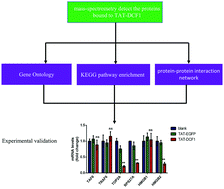当前位置:
X-MOL 学术
›
Mol. Omics
›
论文详情
Our official English website, www.x-mol.net, welcomes your
feedback! (Note: you will need to create a separate account there.)
Proteomics and molecular network analyses reveal that the interaction between the TAT-DCF1 peptide and TAF6 induces an antitumor effect in glioma cells.
Molecular Omics ( IF 3.0 ) Pub Date : 2020-02-17 , DOI: 10.1039/c9mo00068b Jiao Wang 1 , Fushuai Wang , Qian Li , Qian Wang , Jie Li , Yajiang Wang , Jiamin Sun , Dongfang Lu , Hong Zhou , Shiman Li , Sujuan Ma , Jiang Xie , Tieqiao Wen
Molecular Omics ( IF 3.0 ) Pub Date : 2020-02-17 , DOI: 10.1039/c9mo00068b Jiao Wang 1 , Fushuai Wang , Qian Li , Qian Wang , Jie Li , Yajiang Wang , Jiamin Sun , Dongfang Lu , Hong Zhou , Shiman Li , Sujuan Ma , Jiang Xie , Tieqiao Wen
Affiliation

|
Glioblastoma is the most lethal brain cancer in adults. Despite advances in surgical techniques, radiotherapy, and chemotherapy, their therapeutic effect is far from significant, since the detailed underlying pathological mechanism of this cancer is unclear. The establishment of molecular interaction networks has laid the foundation for the exploration of these mechanisms with a view to improving therapy for glioblastoma. In the present study, to further explore the cellular role of DCF1 (dendritic cell-derived factor 1), the proteins bound to TAT-DCF1 (transactivator of transcription-dendritic cell-derived factor 1) were identified, and biosystem analysis was employed. Functional enrichment analyses indicate that TAT-DCF1 induced important biological changes in U251 cells. Furthermore, the established molecular interaction networks indicated that TAT-DCF1 directly interacted with TAF6 in glioma cells and with UBC in HEK293T (human embryonic kidney 293T) cells. In addition, further biological experiments demonstrate that TAT-DCF1 induced the activation of the RPS27A/TOP2A/HMGB2/BCL-2 signaling pathway via interaction with TAF6 in U251 cells. Taken together, these findings suggest that the TAT-DCF1 peptide possesses great potential for the development of glioblastoma therapy through the interaction with TAF6-related pathways and provides further theoretic evidence for the mechanisms underlying the antitumor effects of TAT-DCF1.
中文翻译:

蛋白质组学和分子网络分析表明,TAT-DCF1肽和TAF6之间的相互作用在神经胶质瘤细胞中诱导了抗肿瘤作用。
胶质母细胞瘤是成人中最致命的脑癌。尽管外科手术技术,放射疗法和化学疗法取得了进步,但由于该癌症的详细潜在病理机制尚不清楚,因此其治疗效果远未达到显着水平。分子相互作用网络的建立为探索这些机制以改善胶质母细胞瘤的治疗奠定了基础。在本研究中,为进一步探讨DCF1(树突状细胞来源的因子1)的细胞作用,鉴定了与TAT-DCF1(转录树突状细胞来源的因子1的反式激活因子)结合的蛋白质,并进行了生物系统分析。功能富集分析表明,TAT-DCF1诱导U251细胞发生重要的生物学变化。此外,建立的分子相互作用网络表明,TAT-DCF1与神经胶质瘤细胞中的TAF6直接相互作用,与HEK293T(人胚肾293T)细胞中的UBC直接相互作用。此外,进一步的生物学实验表明,TAT-DCF1通过与U251细胞中的TAF6相互作用诱导RPS27A / TOP2A / HMGB2 / BCL-2信号通路的激活。综上所述,这些发现表明,TAT-DCF1肽通过与TAF6相关途径的相互作用,具有发展成胶质母细胞瘤疗法的巨大潜力,并为TAT-DCF1的抗肿瘤作用机理提供了进一步的理论证据。进一步的生物学实验表明,TAT-DCF1通过与U251细胞中的TAF6相互作用诱导RPS27A / TOP2A / HMGB2 / BCL-2信号通路的激活。综上所述,这些发现表明,TAT-DCF1肽通过与TAF6相关途径的相互作用,具有发展成胶质母细胞瘤疗法的巨大潜力,并为TAT-DCF1的抗肿瘤作用机理提供了进一步的理论证据。进一步的生物学实验表明,TAT-DCF1通过与U251细胞中的TAF6相互作用诱导RPS27A / TOP2A / HMGB2 / BCL-2信号通路的激活。综上所述,这些发现表明,TAT-DCF1肽通过与TAF6相关途径的相互作用,具有发展成胶质母细胞瘤疗法的巨大潜力,并为TAT-DCF1的抗肿瘤作用机理提供了进一步的理论证据。
更新日期:2020-02-18
中文翻译:

蛋白质组学和分子网络分析表明,TAT-DCF1肽和TAF6之间的相互作用在神经胶质瘤细胞中诱导了抗肿瘤作用。
胶质母细胞瘤是成人中最致命的脑癌。尽管外科手术技术,放射疗法和化学疗法取得了进步,但由于该癌症的详细潜在病理机制尚不清楚,因此其治疗效果远未达到显着水平。分子相互作用网络的建立为探索这些机制以改善胶质母细胞瘤的治疗奠定了基础。在本研究中,为进一步探讨DCF1(树突状细胞来源的因子1)的细胞作用,鉴定了与TAT-DCF1(转录树突状细胞来源的因子1的反式激活因子)结合的蛋白质,并进行了生物系统分析。功能富集分析表明,TAT-DCF1诱导U251细胞发生重要的生物学变化。此外,建立的分子相互作用网络表明,TAT-DCF1与神经胶质瘤细胞中的TAF6直接相互作用,与HEK293T(人胚肾293T)细胞中的UBC直接相互作用。此外,进一步的生物学实验表明,TAT-DCF1通过与U251细胞中的TAF6相互作用诱导RPS27A / TOP2A / HMGB2 / BCL-2信号通路的激活。综上所述,这些发现表明,TAT-DCF1肽通过与TAF6相关途径的相互作用,具有发展成胶质母细胞瘤疗法的巨大潜力,并为TAT-DCF1的抗肿瘤作用机理提供了进一步的理论证据。进一步的生物学实验表明,TAT-DCF1通过与U251细胞中的TAF6相互作用诱导RPS27A / TOP2A / HMGB2 / BCL-2信号通路的激活。综上所述,这些发现表明,TAT-DCF1肽通过与TAF6相关途径的相互作用,具有发展成胶质母细胞瘤疗法的巨大潜力,并为TAT-DCF1的抗肿瘤作用机理提供了进一步的理论证据。进一步的生物学实验表明,TAT-DCF1通过与U251细胞中的TAF6相互作用诱导RPS27A / TOP2A / HMGB2 / BCL-2信号通路的激活。综上所述,这些发现表明,TAT-DCF1肽通过与TAF6相关途径的相互作用,具有发展成胶质母细胞瘤疗法的巨大潜力,并为TAT-DCF1的抗肿瘤作用机理提供了进一步的理论证据。











































 京公网安备 11010802027423号
京公网安备 11010802027423号